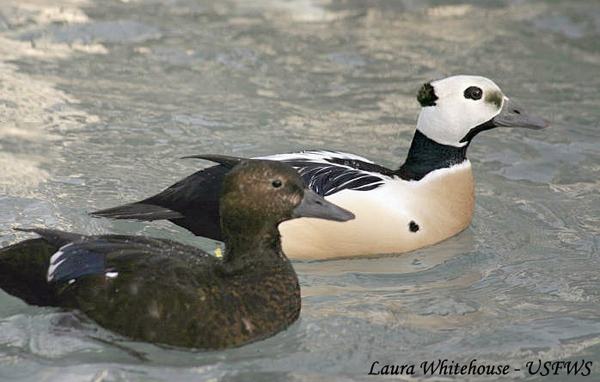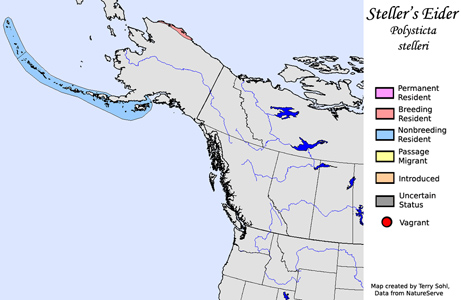| Length: 17 inches | Wingspan: 27 inches | Seasonality: Non-resident in South Dakota |
| ID Keys: Adult breeding males unmistakable. Nonbreeding adults of both sexes are dark brown overall with dark gray bill. | ||
 The
Steller's Eider is an unusual and increasingly rare duck of Alaska and the
Bering Sea. They have a very small breeding range in Alaska (as well
as in parts of Russia), with most wintering in the Bering Sea, around the
Aleutian Islands. Numbers have significantly declined in recent
decades, for reasons that are as of yet not fully understood. The
Alaskan population is considered threatened by U.S. Fish & Wildlife, while
the
IUCN lists the species as "vulnerable".
The
Steller's Eider is an unusual and increasingly rare duck of Alaska and the
Bering Sea. They have a very small breeding range in Alaska (as well
as in parts of Russia), with most wintering in the Bering Sea, around the
Aleutian Islands. Numbers have significantly declined in recent
decades, for reasons that are as of yet not fully understood. The
Alaskan population is considered threatened by U.S. Fish & Wildlife, while
the
IUCN lists the species as "vulnerable".
Habitat: Steller's Eider are found on low-elevation tundra with many freshwater lakes and ponds during the summer breeding season. In winter, they are in salt water habitats, either around rocky shores or on the edges of the pack ice in the Bering Sea.
Diet: Feeds on a variety of items depending upon season and location, but feeds heavily on mollusks and crustaceans when available. They will also take aquatic insects, worms, small fish, and some plant material.
Behavior: Strong divers, much of their food is obtained by diving and swimming underwater. During the summer breeding season, when they are in and around shallower waters, they will also often act in a fashion similar to dabbling ducks.
Nesting: The Steller's Eider nests on Alaskan tundra, using small depressions near water. The nest is lined with down and plant material. The female alone incubates the eggs. The young leave the nest just after hatching and are protected by the female, but the young gather all their own food.
Song: Not a very vocal species. The male is generally silent, while the female will occasionally give low coos and calls.
Migration: Most Steller's Eiders that breed in Alaska winter in the southern part of the Bering Sea, in and around the Aleutian Islands. Much smaller numbers may winter in Scandinavia.
Interactive eBird map: Click here to access an interactive eBird map of Steller's Eider sightings
Similar Species: Males in breeding plumage are unique. Females and non-breeding males are possibly confused with Harlequin Ducks.
Conservation Status: The IUCN currently lists the Steller's Eider as "Vulnerable". Populations in and around Alaska have precipitously declined in recent decades. Reasons for the decline aren't well understood, but heavy metal poisoning or other contaminants may be reducing breeding effectiveness of the species. Changes in the Arctic pack ice due to global warming may also be contributing to the decline.
Further Information: 1) Cornell's All About Birds - Steller's Eider
2) Ducks Unlimited - Steller's Eider
3) U.S. Fish and Wildlife Center - Species Profile - Steller's Eider
Photo Information: September 30th, 2010 - Alaska Sea Life Center in Seward, Alaska - Photo by Laura Whitehouse of the U.S. Fish and Wildlife Service - Photo licensed under Creative Commons Attribution 2.0 Generic license.
| Click below for a higher-resolution map |
 |
| South Dakota Status: Non-resident in South Dakota |
Additional Steller's Eider Photos (Coming Soon!)
